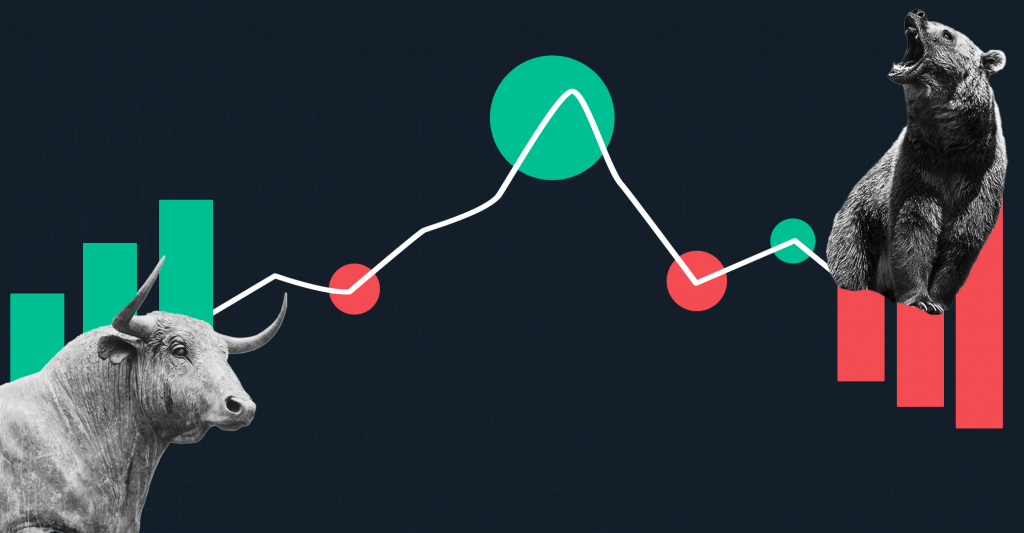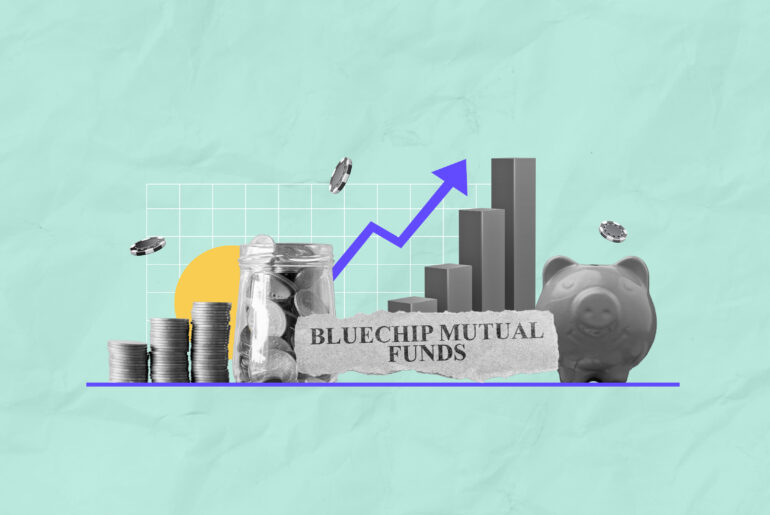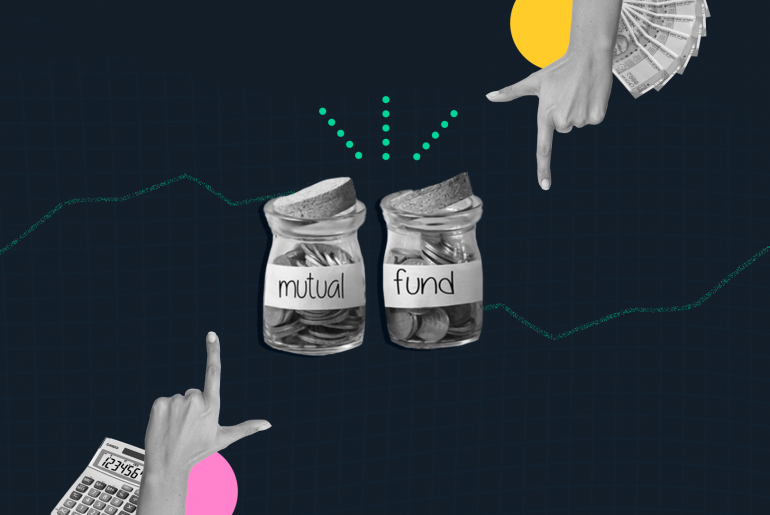Last Updated on May 3, 2023 by Harshit Singh
Investors aim to earn good returns on their investments. A good mix of different asset classes in an investment portfolio will help the investor achieve good returns with balanced risk. Most investors prefer equity and avoid debt in their portfolios. But even for an aggressive investor, having a fair share of debt in the portfolio will balance the risk. Debt mutual funds are low-risk instruments that will keep you covered during volatile times in the market.
Table of Contents
What are debt mutual funds?
Mutual funds are one of the famous investment options in India. The need for limited risk mutual funds gave rise to debt funds. These are famously known as debt mutual funds, bond funds, or fixed-income funds.
Debt mutual funds invest in fixed-income instruments like bonds, government securities, treasury bills, short term plans and liquid funds. They provide steady income to the investors. As the investment involves fixed-income secure instruments, market fluctuations do not have much effect on the returns. Hence, debt mutual funds are ideal for investors looking for low-risk instruments.
How do debt mutual funds work?
As the name suggests, the funds in the debt funds are lent to the companies or the government. When a government or corporate entity needs liquidity, instead of borrowing from the bank or financial institution, they issue bonds. There is a fixed maturity date and interest rate determined on the bond at the time of purchase. Retail investors can invest in these securities through mutual funds. As per the predetermined terms, the investor gets the interest rate, and at the time of maturity, the principal investment is given back.
The mutual fund managers carefully pick the debt securities such as corporate and government bonds, corporate debt securities, and money market instruments that offer capital appreciation and invest the capital.
The important task of the fund manager is to find the right debt instrument by assessing the credit risk and picking underlying assets for the funds. As the underlying fixed income asset generates interest, the value of the fund goes up. Though the returns on the debt mutual funds are stable, they are not fixed. Any changes to the interest rates in the market can fluctuate the returns.
Types of debt mutual funds
Debt mutual funds are further categorised into several types according to the investment horizon, underlying assets and variability of returns. The different types of debt mutual funds are as follows.
1. Overnight funds
These are considered extremely safe funds, similar to savings accounts. The minimum maturity period on this fund is just one day.
2. Liquid funds
The investment is made in debt securities with a maturity period from 1 week to 91 days. Here the risk and returns both are low.
3. Low duration funds
These offer reasonable returns, and the risk level is moderate. The maturity term on these funds is 6 months to 1 yr, which is slightly longer than the ultra-short duration funds.
4. Ultra-short duration funds
The investment is made in the debt securities with a maturity period of 3 to 6 months. The returns offers are quite high as compared to the fixed deposits.
5. Money market funds
These are open-ended schemes where the capital is invested in money market instruments for a year.
6. Short duration funds
These funds invest in short-term instruments like short-term government bonds, corporate bonds, and debentures. The maturity period is 1 to 3 yrs.
7. Medium duration funds
Similar to the short duration funds, debt instruments are picked, but the maturity period is 3 – 4 yrs.
8. Medium to long-duration funds
Here the investment is made in the debt securities with a maturity period of 4 to 7 yrs. These funds carry a bit higher interest rate risk. They tend to perform well when the interest rates are falling and vice versa.
9. Long-duration funds
The investment is made in long-duration debts with a maturity of more than 7 yrs. They carry higher risk as compared to any other funds mentioned above. But when compared to equity mutual funds, the risk is low.
10. Corporate bond funds
While all the above-mentioned funds are differentiated according to the maturity period, the investment in the corporate bond funds is made according to the credit rating of securities. Cautious investors who are looking for safe and secured debt mutual funds can choose this.
11. Banking and PSU funds
Here, at least 80% of the fund money is invested in banks, PSUs (Public Sector Undertakings) and public financial institutions (PFI).
12. Gilt funds
In these funds, 80% of the fund money is invested in government securities of different maturity periods. Though the default risk is low, the interest rate risk is high.
13. Gilt funds with a 10-year constant duration
In these funds, 80% of the fund money is invested in government securities with 10 yrs’ maturity.
14. Dynamic funds
The investment is made in the debt instruments according to the interest rate movements in the market. The fund manager manages the portfolio as per the market situation.
15. Credit risk funds
In these funds, at least 65% of the fund money is invested in the below high-rated corporate bonds. As the ratings are average, the interest rate offered is high. Risk-averse investors can avoid choosing credit risk funds.
16. Floater funds
In these funds, a minimum of 65% of the fund money is put into the floating-rate bonds. Whenever the interest rate in the market changes, this fund’s interest also changes.
17. Fixed maturity plan(FMP)
These are close-ended debt funds where the investment is made for a fixed period that could be months or years. This eliminates the interest-rate fluctuations in the market.
18. Sectoral fund infrastructure (debt)
The funds are made in the infrastructure sector of the company. These can be sponsored by only non-banking financial companies (NBFCs) or corporates.
19. Debt-interval fund
These funds are a mix of closed-ended and open-ended instruments. The buy/sell of these funds can’t be done frequently.
10 best debt mutual funds to invest in 2023
| Debt Fund Name | Sub Category | Plan | AUM (Rs. in cr.) | CAGR 3Y (%) | CAGR 5Y (%) |
| Aditya Birla SL Medium Term Plan | Medium Duration Fund | Growth | 1,764.41 | 14.63 | 8.73 |
| JM Low Duration Fund | Low Duration Fund | Growth | 149.45 | 11.29 | 5.34 |
| IDBI Credit Risk Fund | Credit Risk Fund | Growth | 22.79 | 11.16 | 3.74 |
| Baroda BNP Paribas Credit Risk Fund | Credit Risk Fund | Growth | 181.43 | 10.57 | 7.64 |
| UTI Dynamic Bond Fund | Dynamic Bond Fund | Growth | 363.07 | 10.13 | 6.26 |
| UTI Bond Fund | Medium to Long Duration Fund | Growth | 295.88 | 9.76 | 4.44 |
| Nippon India Credit Risk Fund | Credit Risk Fund | Growth | 999.74 | 9.04 | 4.61 |
| IDBI ST Bond | Short Duration Fund | Growth | 26.27 | 8.99 | 6.95 |
| Bank of India Short Term Income Fund | Short Duration Fund | Growth | 79.04 | 8.84 | 4.13 |
| Aditya Birla SL Credit Risk Fund | Credit Risk Fund | Growth | 1,029.16 | 8.82 | 7.23 |
Note: The data is as of 21st April 2023. The above list of debt mutual funds in India was made using Tickertape Mutual Fund Screener using the following filters:
- Category – Debt
- Plan – Growth
- CAGR 3 yr – set from high to low
- CAGR 5 yr – 0 to high
Aditya Birla SL Medium Term Plan
Aditya Birla Sun Life AMC Limited is a collaboration between the Aditya Birla Group and Sun Life Financial Inc. from Canada. This joint venture combines the Aditya Birla Group’s knowledge of the Indian market with Sun Life’s worldwide expertise. The fund has an exit load of 2%. Over the past year, the fund has produced a steady return of 23.10%.
JM Low Duration Fund
JM Financial Asset Management Private Limited is a mutual fund company that began operating in 1993-94, making it one of the earliest privately-owned mutual fund companies. It is a subsidiary of the well-established JM Financial Group. This relatively small-sized fund has a zero percent exit load and a minimum lump sum investment amount of ₹1,000.
IDBI Credit Risk Fund
IDBI Mutual Fund, which was launched in 2010 by IDBI Bank, is a profitable AMC with an asset base exceeding ₹5,300 crore. The fund house offers 22 schemes with a strong asset base across various products, regions, and investors. The fund imposes a 1% exit load and requires a minimum lump sum investment of ₹5,000.
Baroda BNP Paribas Credit Risk Fund
Baroda BNP Paribas Mutual Funds introduced a credit risk debt fund on 23 January 2015, which currently has an AUM of ₹181.43 cr. as of 21 April 2023. The fund has an expense ratio of 0.78% and a 3-yr CAGR of 10.57%. The minimum lump sum investment amount for this fund is ₹5,000.
UTI Dynamic Bond Fund
This scheme was introduced by UTI Mutual Fund on 16 June 2010 and currently has a month-end AUM (Assets Under Management) of ₹363.07 cr. as of 21 April 2023, with an expense ratio of 1.30%. The scheme has a 3-yr CAGR of 10.13% and a 5-yr CAGR of 6.26%.
UTI Bond Fund
UTI Asset Management Company (AMC) started functioning on 1 February 2003, and has been backed by four promoters, namely SBI, Life Insurance Corporation of India, Bank of Baroda, and Punjab National Bank, each owning a 25% stake in UTI AMC’s paid-up capital. This compact fund imposes an exit load of 3%, and the minimum lump sum investment amount allowed is ₹500.
Nippon India Credit Risk Fund
Nippon India Mutual Fund, with an Average Assets Under Management (AAUM) of ₹2,79,431 cr., is a prominent mutual fund in India. It was established as a trust under the Indian Trusts Act, 1882, with Nippon Life Insurance Company as its Sponsor and Nippon Life India Trustee Ltd as its Trustee. The fund has an exit load of 1% and allows a minimum lump sum amount of ₹500.
IDBI ST Bond
Founded in 2010, IDBI Mutual Fund is a profitable asset management company with an asset base of over ₹5,300 cr. It was promoted by IDBI Bank and offers 22 schemes across a wide range of products, geographies, and investors. This fund has a small size and no exit load, with a minimum lump sum amount of ₹5,000 allowed.
Bank of India Short Term Income Fund
The BOI Asset Management Company has a wealth of experience in managing funds for investors with diverse investment objectives for over 14 yrs. With an asset under management (AUM) of over 2700+ cr. and a clientele of 2 lakh+ investors, the fund house manages 17 mutual fund schemes. This small-sized fund has a minimum lump sum amount of ₹5000 and does not have an exit load.
Aditya Birla SL Credit Risk Fund
Aditya Birla Sun Life AMC Limited is a collaboration between Aditya Birla Group and Canada’s Sun Life Financial Inc. The alliance leverages the Aditya Birla Group’s local market expertise and Sun Life’s global experience. This fund has a mid-size asset base and imposes an exit load of 3%, while the minimum lump sum investment amount is ₹100.
Should you invest in debt mutual funds?
Debt mutual funds are well-suited:
- For risk-averse investors who are seeking regular income.
- For the investors who are looking for options to park their funds safely for a short period.
- For the first-time investors who are new to mutual funds and looking for low-risk instruments and a replacement for bank fixed deposits.
How to choose the best debt mutual funds for you?
Having several debt mutual funds options can be confusing for an investor. As not all debt mutual funds work in the same way, we’ve listed the way you need to choose the right one for you.
1. Investor profile
An investor’s profile is a key factor before jumping on to any investment. It won’t be ideal for a person close to retirement to invest in a high-risk instrument. The fund scheme should be picked according to the investor’s goal and age.
2. Maturity period
Most debt mutual funds vary according to the maturity period and this is the most important factor to consider as well. If you aim to invest for a shorter period of around 3 mth to 1 yr, then liquid funds could possibly be a better choice for you. Else if you are planning to stay invested for about 1-3 yrs can opt for short-term debt funds. Those with long-term objectives for about 3-5 yrs can pick medium-term bonds.
3. Risk
It is well-known that every investment carries at least a little amount of risk. Debt funds are exposed to interest-rate risk and credit risk. Hence it is essential to look into the history of the fund to avoid these risks.
Taxes on debt mutual funds in India
In India, the taxation on debt mutual funds in FY 2022-2023 depends on the holding period of the fund. Short-term investments, less than three years, are taxed based on the investor’s income slab. Long-term investments, more than three years, are taxed at 20% after indexation. Indexation is the process of accounting for the effect of inflation on an asset.
However, after recent changes, if an investor sells their debt mutual fund investments after three years from the investment date, they will be subject to short-term capital gains tax. The tax liability will depend on the investor’s tax bracket, with those in the 20%-30% tax bracket being negatively impacted by the changes.
For example, if an investor bought a debt mutual fund for ₹10,00,000 in FY 2017-18 and sold it for ₹20,00,000 in FY 2022-23, they would have to pay a long-term capital gains tax of 20% after indexation, which amounts to ₹1,56,618. However, if the same investor sells their investments after the recent changes, they would have to pay short-term capital gains tax, which would depend on their tax bracket, with those in the 20%-30% tax bracket paying up to ₹3,00,000.
Long-term capital gains tax after the recent changes in debt fund taxation:
| Tax Bracket | Before amendment to debt fund taxation rule | After amendment to debt fund taxation rule |
| 30% tax bracket | 1,56,618 | 3,00,000 |
| 20% tax bracket | 1,56,618 | 2,00,000 |
| 10% tax bracket | 1,56,618 | 1,00,000 |
FAQs
1. Are short-term debt funds better than long-term funds?
If you have to meet your short-term goals then short-term debt funds can be a preferred option. It depends on the investor’s goal, risk appetite and time horizon.
2. What are the best debt funds for 1 yr?
You can check money market funds, which can be the best debt funds for 1 yr. The maturity period for the money market fund is 1 yr.
3. Is there any lock-in period for the debt funds?
No. Unlike fixed deposits, there is no lock-in period for the debt funds.
4. What are the best debt funds for the long term?
There are several types of debt funds for the long term. If the time horizon is 1 to 3 yrs then short-term funds are good. If the time period is long, about 3 – 4 yrs, then medium-term funds are preferred. If you are looking for debt funds with 4 to 7 yrs’ maturity, then medium to long-duration funds can be chosen, while, if the time period is more than 7 yrs then long duration funds can be chosen.
However, it is important to remember that with the time period, the risk also increases. There can be credit risk, interest rate risk and inflation risk. But the debt mutual funds possess less risk as compared to equity mutual funds and can expect stable returns.
- How To Withdraw Mutual Funds? - Jun 6, 2025
- Top Maternity Insurance With Low Waiting Periods - Jun 5, 2025
- ROE vs ROCE – What are the Differences? - Jun 5, 2025






Really appreciate your work and guidence sir.